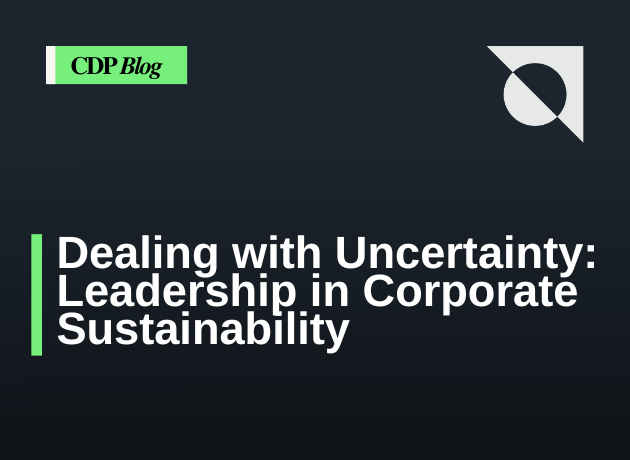
Submitted by sude.figen on February 13, 2025
Uncertainty can’t be a crutch for inaction in 2025. What else should we be looking out for?
On the eve of Davos, CDP CEO Sherry Madera discusses why businesses must embrace leadership over uncertainty.
As I plan for a week in the mountains at the World Economic Forum's Annual meeting, “uncertainty” is emerging as an uncomfortable buzzword. It makes me nervous because it underscores a mindset we need to leave behind. Whether it’s economic uncertainty, political uncertainty or uncertainty about the pace of climate action, this word has become a crutch for inaction.
Instead, let’s talk about something far more empowering: leadership. It is a challenge to lead when you don’t have all the information – the data – you need to make decisions.
However, we all know we can’t let the perfect be the enemy of the good. This is true for sustainability decisions. We know climate data is not fully comprehensive yet, but we can’t let that get in the way of taking Earth-positive decisions, today. To be leaders where it matters most.
Despite the headlines about faltering alliances or wavering commitments, I think something different is happening. Businesses aren’t retreating from their sustainability plans. Many are stepping forward. Corporate climate action is proving resilient against political flux, and 2025 might just be the year we witness a tipping point – when corporate leadership becomes the antidote to political uncertainty.
In an attempt to walk the walk on leading in uncertain times, here are the five trends I think we need to be looking out for in the coming months.
1. Climate reporting is the new normal
This is the year mandatory climate reporting goes mainstream. Europe’s CSRD, China’s expanded disclosure mandates, and the uptake of new global standards such as the ISSB are bringing thousands of companies into the disclosure community.
But this isn’t just a compliance story. It’s about setting a new baseline for corporate transparency and accountability. Leaders are already moving from ambition to action, demonstrating measurable outcomes. The companies that embrace this shift will outpace their peers – not because they had to, but because they chose to. Data surfaced about climate risks, impacts, actions and opportunities is driving better core business decisions because data for compliance is the same data used for customers, operations, innovation and attracting investment.
2. Nature will enter the boardroom
For years, nature was the afterthought in corporate climate strategies. Not anymore.
The Kunming-Montreal Global Biodiversity Framework has galvanized action, with biodiversity disclosures jumping an enormous 43% in 2024. Across industries, data on a company’s dependence on nature is no longer a ‘nice-to-have’ but a competitive necessity. The manufacturing and construction sectors are increasingly integrating circularity, proving that environmental stewardship can be an engine for innovation. In 2025, nature isn’t just part of the conversation – it’s driving it. Nature has pulled up a chair at the board table.
3. AI and the renewable energy imperative
Artificial intelligence is everywhere, and its potential to accelerate innovation is undeniable. But it comes with a catch: the need for energy. AI’s insatiable energy appetite is pushing renewable energy to the forefront of corporate agendas. Leading tech companies face a critical test: scaling renewables fast enough to maintain sustainable AI growth – no matter their company’s primary sector. The race to triple global renewable energy capacity by 2030 is a rallying cry for every sector, not just tech. The businesses that align AI growth with renewable investments in 2025 will redefine what innovation means in a sustainable world.
4. Greenhushing or backsliding? Accountability prevails
Let’s not confuse the headlines with the bigger picture. Companies are not backing away from climate commitments. They are backing out of alliances. That's very different. CDP’s data shows that more companies increased their climate ambitions in 2024 than reduced them. Accountability – from investors, consumers, and regulators – is a powerful force. Businesses that actively reduced supply chain emissions saved over US$13 billion last year, proving that sustainability is good for the planet and the bottom line. The real outliers aren’t the ones backsliding; they’re the ones standing still.
5. Corporate climate action will thrive amid political uncertainty
Political change is nothing new, so why should businesses let that dictate their climate strategies? Aligning sustainability with profitability builds resilience.
The number of US companies disclosing through CDP today has more than doubled since 2016. Meanwhile, in Asia-Pacific, environmental disclosures surged 30% last year alone, signaling a shift in Asian markets. These businesses understand that delaying transparency risks not just environmental consequences but also market competitiveness. Leadership here means seeing beyond short-term political cycles to the long-term benefits of climate action.
From uncertainty to leadership – it’s not an option
We’ll always have some degree of uncertainty; it’s unavoidable, and it does add some spice to life. We don’t have to let it define us though. In 2025, new forms of leadership should be the defining story. Businesses that embrace climate action as a pathway to resilience and innovation will lead the way in transforming markets.
Some stark facts make this type of leadership a necessity. If we do nothing differently, the WEF predicts we will lose 12% of global GDP with every 1° rise in the earth’s temperature. Earth-positive action is not optional for businesses who seek a favorable economy to operate.
At CDP, we’re proud to serve the economic leaders of today and tomorrow with comparable, comprehensive and coherent data that can be used for multiple use cases. Let’s make 2025 the year we fret less about uncertainty and embrace a future defined by sustainable, decisive leadership.





